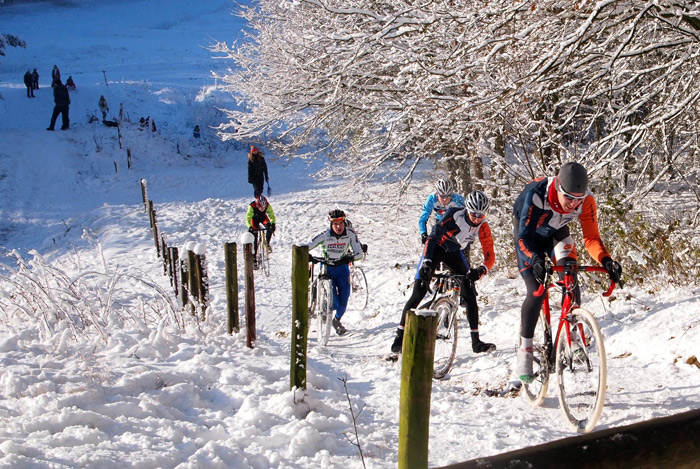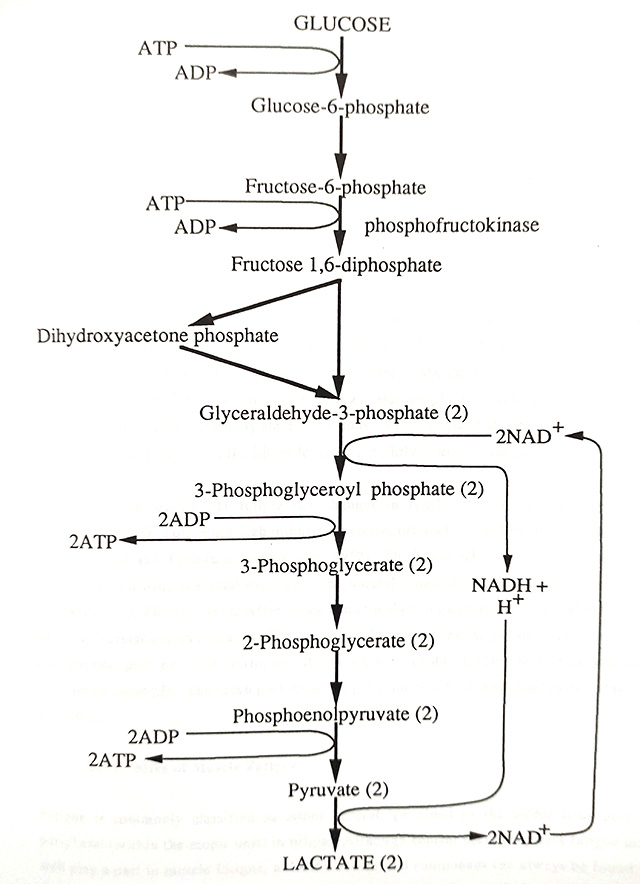Complex biochemical reactions occur within the body to provide the energy for processes that keep us alive, and during exercise, the energy for muscular contraction to do physical work.
 ATP stores need to be replenished quickly while cycling up hill
ATP stores need to be replenished quickly while cycling up hillThe energy for muscular contraction is derived from the hydration of adenosine triphosphate (ATP) to form adenosine diphosphate (ADP). The energy stored within the high energy phosphate bonds of ATP is released by the following reaction, catalysed by the enzyme ATPase:
ATP + H2O <------ ATPase ------> ADP + Pi + energy
The chemical bond energy released by this reaction is utilised in many cellular processes, including the coupling of the muscle filaments, actin and myosin, which results in the production of muscular force.
Replenishment of ATP Stores
The stores of ATP within the muscle cells are low, so for muscle contraction to continue, ATP must be resynthesised. The resynthesis of ATP is the reversal of the equation above, in which the energy input is derived from another high energy compound, phosphocreatine (PC), or by the breakdown of ingested fuels (fats, carbohydrates and proteins). The breakdown of ingested fuels, and therefore resynthesis of ATP, can be via aerobic pathways (with oxygen), or anaerobic pathways (without oxygen). The relative contribution of aerobic and anaerobic energy systems vary with the duration and intensity of the exercise.
The 'Alactic' Anaerobic System
The intramuscular levels of ATP are approximately 5 mmol.kg muscle-1, and for high intensity, short duration sprints, it is enough to last for only one or two seconds. Another high energy compound, phosphocreatine (PC), is also present in muscle cells. PC is found in concentrations of approximately three to five times that of ATP. The breakdown of PC can produce energy to quickly resynthesise ADP to ATP, and therefore maintain ATP concentration, by the following reaction, catalysed by the enzyme creatine kinase:
Phosphocreatine + ADP <------- Creatine Kinase -------> Creatine + ATP
The PC stores can only resynthesise enough ATP to maintain contraction for up to 10 seconds, at which time anaerobic glycolysis becomes the predominant energy system.
 The biochemical pathway of anaerobic glycolysis. The number in brackets indicates two molecules produced for every one molecule of glucose.
The biochemical pathway of anaerobic glycolysis. The number in brackets indicates two molecules produced for every one molecule of glucose.'Lactic' Anaerobic System
As the cellular stores of ATP and PC are limited, ATP needs to be supplied from other sources. For high intensity exercises, lasting up to approximately two to three minutes, ATP is resynthesised predominantly by a process called anaerobic glycolysis. This involves the breakdown of glucose to form lactate (La-) and ATP (see diagram above). The sequence of reactions from glucose to pyruvate is a common sequence for both anaerobic and aerobic glycolysis. NAD (the oxidised form of nicotinamide adenine dinucleotide) is a necessary substrate for the reaction of glyceraldehyde 3-phosphate to 3-phosphoglycerol phosphate, and can be supplied by the oxidation of NADH (the reduced form of nicotinamide adenine dinucleotide) in the mitochondrion, or through the reduction of pyruvate to lactate.
In high-intensity exercise, the rate of ATP demand exceeds the capacity of the citric acid cycle to support mitochondrial oxidation. In order to maintain glycolysis, and therefore ATP resynthesis, NAD is supplied by the reaction of pyruvate to lactate.
Pyruvate + NADH + H+ <----------> La- + NAD
The sequence of reactions in anaerobic glycolysis has the net result of producing two molecules of ATP for every molecule of glucose, as shown in the overall equation below:
Glucose + 2Pi + 2ADP --------> 2La- + 2ATP + 2H2O
The main products of glycolysis are ATP, for muscle contraction, and lactate, which can accumulate in the muscle cell. Dealing with the levels of lactate in the muscle is an important part of fitness training.
Related Pages
- The Energy Systems — a simpler view
- The Human Engine
- About Sports Medicine
Disclaimer


 Current Events
Current Events